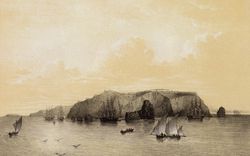Toys Shape Minds no. 6
Texts by Norman Brosterman, Rosemary Haddad, Brooke Hodge, and Michael Lewis
Events in “real” architecture eventually make their way into toy architecture, often with little time lag. The metal-framed Erector set of 1909 challenged the traditional wood block with a light, tensile-frame alternative, just as the curtain-wall construction of modern skyscrapers was challenging the traditional masonry bearing wall. But long before the Erector set, in 1885, the skyscraper had already entered the realm of building blocks in the form of the McLoughlin Bros.’ intriguing Sky-Hi. In the same year, William LeBaron Jenney’s nine-storey Home Life Insurance Building in Chicago, the first all-metal-frame skyscraper, was completed. The McLoughlin Bros.’ toy worked from the same principles as did Jenney: for iron columns it used slotted wood uprights that peg together end to end; for fireproof brick curtain walls it used thin cardboard panels.
For all the progressiveness of its construction system, Sky-Hi’s lithographed wall panels hardly pointed to the future. The McLoughlin Bros. artist seemed unable to imagine what metal-frame architecture might look like, and he instead used as a model the only other lightweight framing material he knew: wood. This explains the exotic imagery of the cover, linking Sky-Hi not to skyscrapers but to Japanese wood temple architecture. Most intriguing of all are the delicate wall panels with their kimono-clad women, recalling the Japanese wood-block prints that were delighting American audiences in the 1880s. Not quite skyscraper, not quite pagoda, Sky-Hi shows that in toys as well as in architecture, the invention of new materials often outstrips the ability to find new and appropriate forms.
McLoughlin Bros. was founded in 1827 but did not achieve national fame until about thirty years later, when it began merchandising paper dolls, dollhouse furniture, and toy soldiers. The firm was sold to Milton Bradley in 1920.
Read more
At the beginning of the twentieth century, building toys of metal and steel that reflected the recent development of steel framework construction began to be manufactured, replacing stone and wood construction toys as the most popular tools for young builders. Undoubtedly influenced by the earlier British construction toy Meccano, Erector sets were invented in 1909 by A. C. Gilbert, a New Jersey physician, and put on the market in 1913. The Mysto Erector of 1914 is one of the best known examples of this popular toy, which, in its materials and assembly method, resembles early steel-framed buildings. In fact, its box describes it as “the toy whose girders resemble structural steel” and advertising for the toy states that the intention in creating and marketing Erector sets was to “teach boys the principles of construction and engineering.”
The Erector set is similar to Meccano in that it is composed of girder-like metal strips and nuts and bolts that could be assembled in innumerable ways, but Gilbert made it far more versatile than its English predecessor by adding gears, pinions, and an electric motor. The Erector set was available in many sizes and varieties—including the rare Erector Skyscraper Set of 1935 that added cardboard facade panels to the girders and nuts and bolts—and is believed to be the oldest mass-produced, mass-marketed American-invented toy still on the market today. Gilbert’s annual contests for new Erector designs brought thousands of entries, of which the winning ones were published in the instruction manuals accompanying the following year’s run of the toy and helped to sell thousands more Erector sets.
By 1913 the A. C. Gilbert Company, located on Erector Square in New Haven, Connecticut, had purchased the American interest in Richter’s Anchor Blocks, and in 1920 it purchased the American branch of Meccano. Erector sets, from playground-sized to pocket-sized, are still popular today. In fact, the 17 September 1990 issue of Time refers to a group of Manhattan real-estate developers nicknamed “the Erector set,” who transformed the cityscape in the 1980s.
Ives Manufacturing Corporation was founded in the 1850s by Riley Ives as a metal-stamping shop, and by 1865 it was making tin whistles for New York Rubber’s squeak toys. From about 1870 until it was dissolved in 1932, the company produced an enormous quantity of toys of every type, becoming distinguished especially in the production of metal toys. Ives’s Struktiron is very similar to the Erector set with its black-painted steel girders and metal hardware, and was advertised as “a system of miniature structural steel parts with which…anything which in real life is built of structural steel, can be accurately reproduced.” The observation tower here is based on a construction diagram in the manual accompanying the toy.
By the 1940s, however, plastic became the favoured material of the toy industry and created whole new possibilities for construction toys—new and more intricate shapes, smaller pieces, larger pieces, an exciting range of colour. In around 1957, Elgo Plastics of Chicago introduced American Skyline. This set consists of over seven hundred “precision-made interlocking parts” for building models with “architectural scale 1/8 inch = 1 foot.” With its tab-and-slot assembly system, it makes stunning buildings, which, according to its manual, “[are] designed to follow the most popular trends in architecture.” Indeed, the plastic toy shown here resembles the externally exposed skeleton of buildings such as the World Trade Center in New York. Curtain Wall Builder, produced circa 1959, is another modern skyscraper toy; with its set of plastic windows and turquoise-painted, metal spandrel panels, it builds a miniature Lever House.
These texts appeared in the publications accompanying the exhibitions Building in Boxes and Potential Architecture, which were part of a series we developed during the 1990s exploring the relationship between toys and architecture. We have a significant number of toys and games in our collection.














